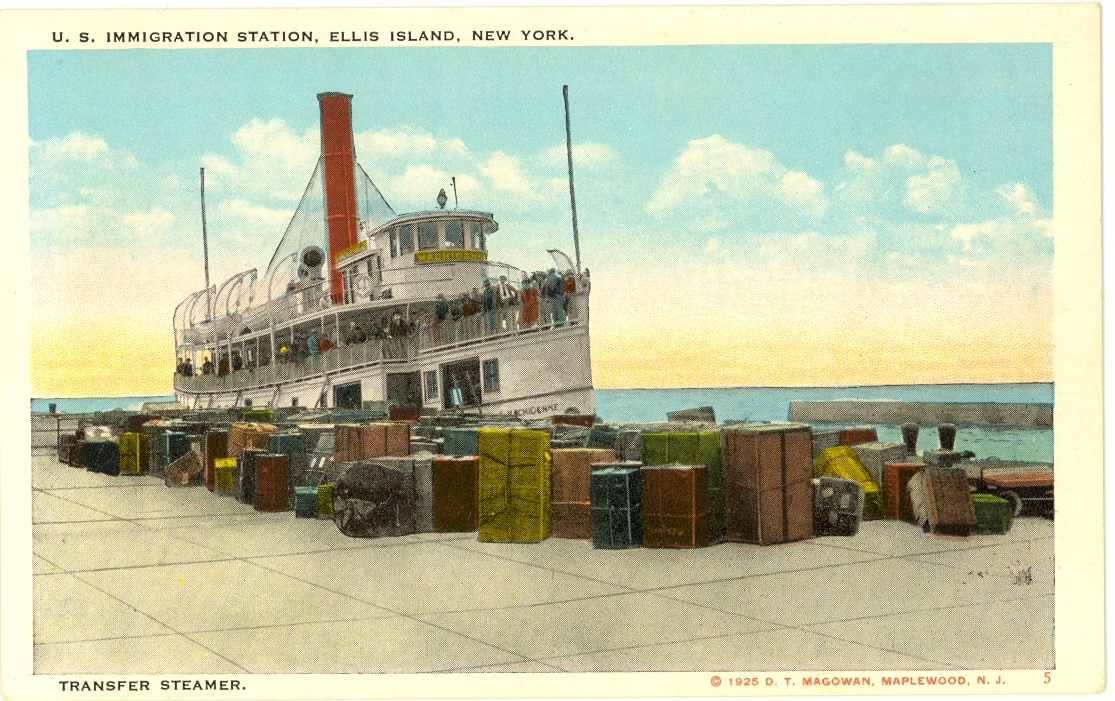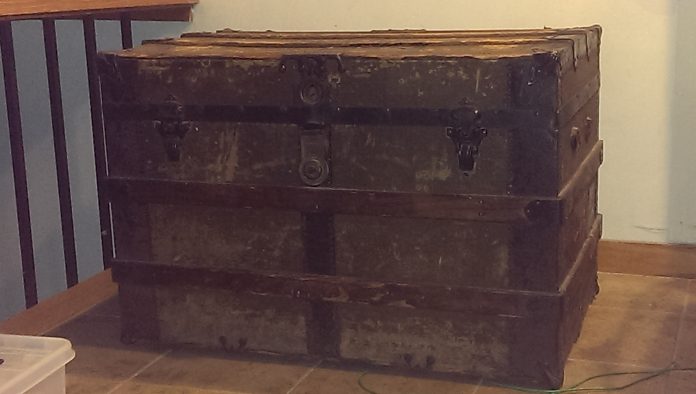
Of the twelve million immigrants who arrived at Ellis Island between 1892 and 1954 four million were Italian and my grandmother, Colomba Cordani, was one of them. She left her small Northern Italian village of Ponte del Olio near Piacenza and arrived in New York on April 27, 1909 aboard the French Line steamship Chicago. The ship departed from LeHarvre two weeks earlier and the spring passage was rough. There were 1,250 steerage passengers and many, including my grandmother, were sea sick the entire voyage. When the Chicago arrived in New York I can only imagine the thrill she and the other passengers felt when they sailed past the Statue of liberty. Steerage passengers were only allowed on deck once a day when the upper class passengers were eating lunch but that day the captain gave them special permission to come on deck to see Miss Liberty welcoming them to the United States.
My grandmother never spoke English but I like to imagine someone translated the words on the base of the statue for her;
Give me your tired, your poor, your huddled masses yearning to breathe free, the wretched refuse of your teeming shore, Send these, the homeless, tempest tossed to me, I lift up my lamp beside the golden door.
The post card I’m sharing today is one of my favorites. It depicts the pier at Ellis Island covered with the suitcases and trunks of newly arrived immigrants who can be seen aboard the ferry boat. The transatlantic steamers would dock at the piers on the Hudson or East rivers where the upper class passengers would disembark first. After that, the steerage passengers would get off and be immediately brought to Ellis Island by a fleet of ferries to be processed. Ellis Island averaged over 5,000 passengers per day who had to be processed so the scene was chaotic. The Italians called Ellis Island L’Isola dell Lagrime, the Island of Tears, because so many were denied admission and sent back.

Almost unique among early immigrants, Italians returned to their homeland often and in remarkable numbers. I have read that 70% of Italians returned to Italy at one time or another and as many as 30% permanently. My grandmother had an uncle, Carlo with whom she lived when she first came to the North End. Carlo and his wife had a small grocery store on the corner of Endicott and Stillman Streets. When their children were grown Carlo and his wife returned to Italy bringing their beautiful cast iron coal burning stove with them. Unlike other immigrants, Italians preferred the rustic life of the Italian countryside to the cold, unforgiving American cities. Jews risked being killed by the Tsar’s soldiers if they returned to Russia and the Irish had no reason to return to a country ravaged by famine. Italians returned home for many reasons, some to visit their families, others to help with the harvest or attend a wedding or funeral. But there was another, more important reason which is largely undiscussed and almost forgotten.
Italians came to l’America for one specific reason and that was to make money. They weren’t fleeing murdering Cossacks or famine nor were they seeking religious freedom. America was the land of opportunity where jobs and money were available to anyone willing to work. Once they had accumulated money they used it in an unusual way, they remitted tremendous amounts of it back to Italy.
Growing up in the North End I always wondered why such a supposedly poor neighborhood had so many banks and travel agencies all of which offered money transfer services. Italian immigrants were generally uneducated and many were illiterate but they weren’t stupid. They had that peasant cleverness bred of centuries of subjugation and desperation. They quickly realized that the value of American dollars was much greater in Italy than here in the States. Unlike Italy, America was still on the gold standard, our paper money was backed by precious metal and the US Treasury couldn’t just keep printing more money to cover its debts. Dollar bills were called “silver certificates” and could be exchanged for real silver coins. This was a bonanza for savvy Italian immigrants. They could live in the North End in the most austere way possible and work like dogs just to accumulate cash which they then remitted back to Italy. Few records were kept but it is estimated that Italians remitted between ten and thirty million dollars per year to Italy, an enormous sum at that time. The fact that the Treasury issued large denomination notes of up to $10,000 and cross Atlantic fares could be as low as $20.00 made this carry trade possible and very lucrative.
The Protestant American aristocracy was appalled at this and considered it un-American and even seditious. They called these Italians “Birds of Passage” because they returned to Italy so often. This transfer of money out of the country was destabilizing the currency and increased the risk of deflation. What they didn’t understand was that mild deflation was the poor man’s friend while inflation is the enemy of the poor.
The money that was remitted back to Italy was used for different things. Some was sent to help families pay debts and taxes or to buy farm land or vineyards but a substantial amount was used to buy Italian products to sell in America. Fulton Street was lined with packing companies, businesses that imported Italian products in bulk, repackaged them under their own labels and sold them through a web of Italian grocery stores. One prominent North End family made a small fortune by obtaining the last shipment of real olive oil just before the shipping lanes were closed by World War II. They sold it throughout the war at a premium.
These remittances are still occurring today but with different ethnic groups. Records are not kept because the individual amounts are small but it is thought that more money leaves the country through remittances every year than is given in foreign aid.
The country that welcomed my grandparents is now welcoming different ethnic groups who want to work and accumulate wealth. They come here because we have freedom and we value the rule of law. The words carved into the base of the Statue of Liberty were an inspiration for generations of immigrants. Let’s not forget that.
Nicholas Dello Russo is a lifelong North Ender and columnist. Often using vintage photographs, Nick tells the stories of growing up in the North End along with its culture and traditions. It was a time when the apartments were so small that residents were always on the streets enjoying “Life on the Corner.” Read more of Nick’s columns.
[hr]


Love the phrase “peasant cleverness” The Italian immigrants had that and then someMy grandmother came over from Calabria and had the wherewithal to study to become a midwife. Patients would give her food and wine in exchange for her duties. Spoke broken English, but she was one of the smartest people I ever knew.. yes, a peasant, but oh so clever!
Great article, Nick , and very apropos !
Cannot wait for Part 2. Your entries are one of the reasons I am a patron of NEWN. Please continue….
Great reading & writing as usual Nick.
Wow Nick great story! My Grandfather came from Riesi,Sicily in on May 24,1912 on SS San Georgio from Palermo,Italy where he lived on Wallace St. Jersey City,New Jersey My Grandmother,age 29, My Mother age 7 and her sister age 4 on the Europa, from Naples on Jan 27,1915 to New Jersey than to 11 Battery St North End Your Story about being in Stearage was the same as told by my mom Sad She left her Grandparents in Italy never to see them again. I have to say she studied hard to become a citizen and didn’t have an actcent! When we visited Ellis Island we cried thinking what they went through Sorry for long story My Mom lived from 1908-to 2014 at the age if 106 Thanks Nick You always have the best story’s and information for sure!!
Corinne, it’s interesting that Marge, you and I all mentioned our grandmothers not our grandfathers. My grandfather had a barber shop on the corner of Haverhill and Causeway streets but he worked six and sometimes seven days a week so I rarely saw him. It was the women who held the families together. Imagine cooking, cleaning and doing laundry for ten people in a four room cold water flat. It’s unimaginable today.
Great story, Nick…so well written. And it comes at a time we need to read and think about your closing paragraph. Very well done and very timely. Thanks.
I would like to add to Nick’s great article,if i may. My grandparents and mother and uncle came from
Avellino,Italy in 1929,although my Papa came a few years earilier to make some money to send for
them. In 1995, my mom was 80 years old. She loved new york city as her and my father went there
on their honeymoon 1939. i decided to take her there for her birthday,as my son was living there at the
time and we showed her the town,as the saying goes. She wanted to see Ellis Island again
so we took her.
As we were waiting in line to get in,she was looking at the building with tears in her eyes and started
telling us stories, things she remembered as she was only 15 years old. Before you know it, she had a small
crowd around her listening to her . The most compelling story was …… as she pointed to windows on the side of the building, she remembered seeing people jumping out into the ocean. They were refused entrance for various
absurd reasons. They were jumping out the windows into the ocean,attempting to reach America ……..swimming. She never heard how many made it, although it could not have been many. I agree and tell
people all the time, my family came from another country, how can we refuse people today, where is the progress? America has been good to every family whose ancestors came here TIME TO PAY IT FORWARD !!!
Julie, the reasons for denial weren’t that absurd, but were more rigorous than today. They were given a battery of physical tests to assure that weren’t infectious and spreading desease. They had to prove that they had the ability to work or had means such that they wouldn’t be a ward of the state. List political affiliations so that they werren’t Marxists or anarchist (an anarchist assassinated President McKinley). They didn’t necessarily need to be literate or speak English, but did have put together simple puzzles from geometric patterns. They didn’t want the mentally challenged.
Most wanted to be Americans. My grandfather would admonish his children to “speak American”. It was hard for them to see their children off to WW II. But they knew a lot better than we about the price to be paid to live in the land of the free.
My grandmother Carmella Sacco came from Avellino in the 1900’s. She was matched to my grandfather Nicola Sacco from the North End. When she arrived she found out that my grandfather was blind. She married him anyway. Had 8 children and two that died very young. They lived on Jackson Ave. I always thought how incredibly brave she was. My grandfather supported his family by tuning pianos “a tinker”. He ended up dying young. We sometimes don’t appreciate how fortunate we are until we hear stories of what our grandparents went through.
Love the stories/memories, Nick! Keep them coming. I’m so impressed by the will and the courage those immigrants had and, I recognize that same determination in today’s immigrants as well. We are so very fortunate and your pieces are reminders of that!
Pidg